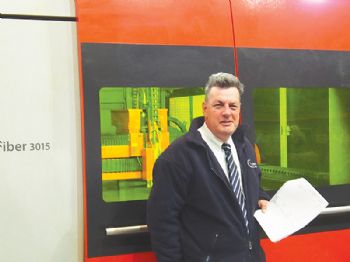
Midtherm Laser specialises in laser cutting and folding; with some 40,000 parts going through its workshop every week, the company needed an efficient way of handling the large volume of administrative work required to deliver high-quality parts on time — and at a competitive cost.
Works manager Mark Hannon said: “We moved to our Dudley site in 2004, and we now have four Bystronic CO2 flat-bed lasers, one Bystronic fibre laser and two press brakes.
“Before we installed our latest software system, we were managing our business with four software packages that did not connect to one another.”
The new CAD/CAM and ERP system from Malvern-based Lantek Systems Ltd (
www.lanteksms.com) has enabled Midtherm to ‘smooth’ its quotation, customer relationship and production processes.
The company can also: nest parts and program all five of its lasers with one system; control non-CNC processes such as folding, powder coating and tapping; and automatically generate delivery notes and invoices.
The company has around 350 live customers, and some of them order parts without asking for a quotation. However, Midtherm still needs to create around 800 quotations every month, which is now a simple and fast process with Lantek.
Mr Hannon says: “We get CAD models, DXF files and drawings — or just a description of the part or kit to be quoted for.
“We manufacture a huge variety of parts for different industries, including pharmaceutical, aerospace, automotive, petrochemical and construction. We import the CAD data, or redraw it where necessary, to get it into the Lantek software.
“All the customer and job data is only entered once. Moreover, we have the price per kg of the materials we use within the system, and this is updated monthly.
“We can then choose how we want to define the material usage; for example, laser with common-line cutting or nest parts in a large cut-out on a particular job.
“The system already knows the cut length, and we have a generic machine defined for cycle-time generation. With this information, we can create new and accurate quotations extremely quickly.”
Default setting
During the configuration of the Lantek system, Midtherm worked through the large number of parameters that are available with one of Lantek’s engineers.
With the defaults set to suit Midtherm’s machines and ways of working, operation is very simple, as the layout of the different screens within the Lantek system is consistent, and the editing parameters, where necessary, are intuitive.
If necessary, the user can even simulate the nest of parts to get an even more accurate cost.
Using the generic-machine configuration gives Midtherm the flexibility to choose which of its five machines to cut parts on; and once a quotation is finished, it is recorded with a unique number and e-mailed to the customer in a format tailored to Midtherm’s requirements.
Moreover, once the order is placed, the quotation becomes the sales order at the click of a button. The parts are amalgamated with all the other ordered parts, according to material type, material thickness and delivery date.
Furthermore, a ‘dynamic nest’ is created; this can feature parts from several customers, as well as stock parts — and even use up tracked and identified sheet remnants from previous operations, thereby maximising material utilisation.
The system also creates a job list for a number of sheets of material, together with a diagram of the individual part and the different nests, thereby allowing easy identification.
A separate job card is issued for a laser-cut part when there are extra operations such as folding or external operations such as tapping. These cards have extra information about how the part is to be folded — or special production instructions for repeat jobs.
As each process is completed, including non-CNC and external operations, the information is fed back into the Lantek Manager software, instantly updating the status of each part.
Mr Hannon says, “Previously, it was very difficult to find out where a part was in the production cycle, but we can now get an answer instantly.
“Searching the data using many different parameters enables us to track an order and ensure on-time delivery; and once the parts or kits have been completed, a delivery note and invoice are automatically generated, and the data is passed to our accounting system.”
He adds: “Our order input has increased vastly and delivery times have gone from 5-7 days to 4-5 days; and despite the recent huge drop in material prices, our turnover has gone up, because we are producing more parts with the same machinery.
“More importantly, profits are up by 10-15%, and administration is much quicker; and because we are using one system, our employees are collaborating much better, as they all understand the complete process and can switch between roles.
“We are now considering a third shift, which will provide us with even more efficiency through reduced energy costs at night.”